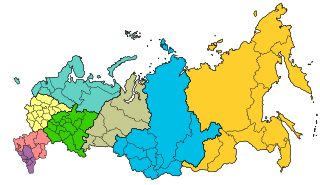Russian is an East Slavic language belonging to the Balto-Slavic branch of the Indo-European language family. It is one of the four extant East Slavic languages, and is the native language of the Russians. It was the de facto and de jure official language of the former Soviet Union. Russian has remained an official language of the Russian Federation, Belarus, Kazakhstan, Kyrgyzstan, and Tajikistan, and is still commonly used as a lingua franca in Ukraine, Moldova, the Caucasus, Central Asia, and to a lesser extent in the Baltic states and Israel.

As of the 2021 census, the population of Russia was 147.2 million. It is the most populous country in Europe, and the ninth-most populous country in the world, with a population density of 8.5 inhabitants per square kilometre. As of 2020, the overall life expectancy in Russia at birth was 71.54 years.

Murmansk is a port city and the administrative center of Murmansk Oblast in the far northwest part of Russia. It sits on both slopes and banks of a modest ria or fjord, Kola Bay, an estuarine inlet of the Barents Sea, with its bulk on the east bank of the inlet. It is in the north of the rounded Kola Peninsula which covers most of the oblast. The city is 108 kilometres (67 mi) from the border with Norway and 182 kilometres (113 mi) from the border with Finland.

Kemerovo Oblast, also known as Kuzbass, after the Kuznetsk Basin, is a federal subject of Russia. Kemerovo is the administrative center and largest city of the oblast. Kemerovo Oblast is one of Russia's most urbanized regions, with over 70% of the population living in its nine principal cities. Its ethnic composition is predominantly Russian, but native Shors and Kalmak Siberian Tatars also live in the oblast, along with Ukrainians, Volga Tatars, and Chuvash. The population recorded during the 2021 Census was 2,600,923.

The federal districts are groupings of the federal subjects of Russia. Federal districts are not mentioned in the nation's constitution, do not have competences of their own, and do not manage regional affairs. They exist solely to monitor consistency between the federal and regional bodies of law, and ensure governmental control over the civil service, judiciary, and federal agencies operating in the regions. The federal district system was established on 13 May 2000.

Ivanovo Oblast is a federal subject of Russia. It had a population of 927,828 as of the 2021 Russian Census.

Voronezh Oblast is a federal subject of Russia. Its administrative center is the city of Voronezh. Its population was 2,308,792 as of the 2021 Census.

Karachay-Cherkessia, officially the Karachay-Cherkess Republic, is a republic of Russia located in the North Caucasus. It is administratively part of the North Caucasian Federal District. As of the 2021 census, Karachay-Cherkessia has a population of 469,865. Cherkessk is the largest city and the capital of the republic.

Stavropol Krai, also known as Stavropolye, is a federal subject of Russia. It is geographically located in the North Caucasus region in Southern Russia, and is administratively part of the North Caucasian Federal District. Stavropol Krai has a population of 2,907,593, according to the 2021 Census.

Astrakhan Oblast is a federal subject of Russia located in southern Russia. Its administrative center is the city of Astrakhan. As of the 2010 Census, its population was 1,010,073.

Volgograd Oblast is a federal subject of Russia, located in the lower Volga region of Southern Russia. Its administrative center is Volgograd. The population of the oblast was 2,500,781 in the 2021 Census.

Lipetsk Oblast is a federal subject of Russia. Its administrative center is the city of Lipetsk. As of the 2021 Census, its population was 1,143,224.

Tambov Oblast is a federal subject of Russia. Its administrative center is the city of Tambov. As of the 2010 Census, its population was 1,091,994.

Oryol Oblast, also known as Orlovshchina (Орловщина), is a federal subject of Russia. Its administrative center is the city of Oryol. Population: 713,374 (2021 Census); 786,935 (2010 Census);

Orenburg Oblast is a federal subject of Russia, mainly located in Eastern Europe. Its administrative center is the city of Orenburg. From 1938 to 1957, it bore the name Chkalov Oblast in honor of Valery Chkalov. As of the 2021 Census, the city has population of 1,862,767.

The Central Federal District is one of the eight federal districts of Russia. Geographically, the district is situated in the extreme west of present-day Russia; although it can be considered as the central region of European Russia. The district covers an area of 650,200 square kilometers (251,000 sq mi), and recorded a population of 40,334,532 in the 2021 Census. The Presidential Envoy to the Central Federal District is Igor Shchyogolev.

Dagestan, officially the Republic of Dagestan, is a republic of Russia situated in the North Caucasus of Eastern Europe, along the Caspian Sea. It is located north of the Greater Caucasus, and is a part of the North Caucasian Federal District. The republic is the southernmost tip of Russia, sharing land borders with the countries of Azerbaijan and Georgia to the south and southwest, the Russian republics of Chechnya and Kalmykia to the west and north, and with Stavropol Krai to the northwest. Makhachkala is the republic's capital and largest city; other major cities are Derbent, Kizlyar, Izberbash, Kaspiysk, and Buynaksk.

The North Caucasian Federal District is one of the eight federal districts of Russia. It is located in extreme southern Russia, in the geographical area of the North Caucasus. The federal district was split from the Southern Federal District on 19 January 2010. The population of the federal subjects comprising the federal district was 10,171,434 according to the 2021 Census, living in an area of 170,400 square kilometers (65,800 sq mi). The current Envoy is Yury Chaika.




















